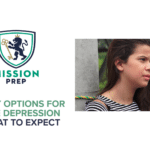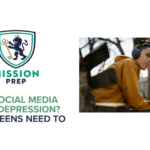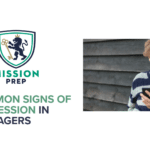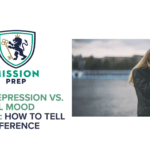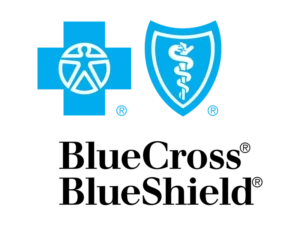Severe Depression in Teens: Recognizing the Signs & How to Help

Severe depression in teens can affect how a young person sees themself, their future, and the world around them. Based on data from 2022-2023, around 4% of children in the U.S. between 3 and 17 years of age were diagnosed with depression.¹ What makes this stat especially concerning is how invisible depression can be, as well as how early its onset often is.
Many teens hide mental health symptoms or withdraw so gradually that loved ones don’t recognize the change in personality until things feel critical. This is why learning to spot the signs of deep depression in youth matters. Whether your teen is showing signs of emotional numbness, withdrawing from social life, or expressing thoughts of hopelessness, early awareness can lead to successful recovery.
If you’re concerned about severe depression in a teen, professional guidance and support are advised. This page can also help, as it explores…
- The signs of severe depression in teens
- Intervention strategies for severe teen depression
- Teen mental health treatments
- How Mission Prep can help with teen depression

What Severe Depression in Teens Looks Like
Severe depression in teens can look different from person to person.² While sadness and crying can be symptoms, silence and withdrawal are often seen too. Sometimes, it’s about a teen who used to seem full of life now seeming flat, irritable, or emotionally numb.
Such changes typically stem from how major depressive disorder in adolescents creates disruptions in mood, motivation, and connection to school, friends, family, and even themselves. Research also shows that untreated depression in adolescents can increase the likelihood of risky behaviors, poor academic and social functioning, and suicidal behaviors.³
Spotting signs of depression early can prevent the condition from becoming severe, so keeping an eye out for the following symptoms may help.
Key Signs of Deep Depression in Youth:⁴
- Persistent feelings of hopelessness
- Withdrawal from friends and activities they once loved
- Fatigue or sleep disturbances, including sleeping too much or too little
- Changes in appetite and weight
- Unexplained anger or irritability
- Low self-esteem and guilt
- Difficulty concentrating
- Emotional numbness, flatness, or emptiness, as well as claims that they “feel nothing”
- Self-harm or suicidal thoughts
Without effective intervention, these symptoms can worsen with time. And in some instances, the onset of youth hopelessness and mental health decline can be sudden and overwhelming.
One of the most concerning elements of teen depression is when teens start experiencing suicidal thoughts.⁵ This doesn’t always mean a teen has a plan, but thoughts like I wish I didn’t exist, or, Everyone would be better off without me, must be taken seriously. If you notice signs like giving away belongings, saying goodbye, or talking about death, these are red flags that emergency help for depressed teens may be urgently needed.
Recognizing the patterns behind teen isolation and withdrawal is an act of prevention. The earlier we notice, the earlier we can intervene.
What Is Depression in the Brain?
Depression isn’t just a series of “bad moods,” but rather a chemical shift in how the brain works. When someone has major depressive disorder, certain brain chemicals, like serotonin, dopamine, and norepinephrine, become imbalanced.⁶ These chemical messengers help regulate temperament, motivation, energy, and sleep. Therefore, when they stop working the way they should, everyday tasks can feel much harder than they usually do.
As teens’ brains are still developing, depression’s onset can be fast and alarming. Plus, once there’s a chemical imbalance, the brain typically needs guidance back to safety and stability.
Common Triggers for Youth Depression⁷
While a teen can sometimes detect triggers for youth depression, other times the condition feels like it creeps in slowly until suddenly the world feels bleak or hopeless. However, the following issues could potentially contribute to the onset of severe depression in teens.
- Ongoing stress at school or home
- Major changes (like death, divorce, moving house, or a friendship ending)
- Long-term social isolation or bullying
- Hormonal shifts during adolescence
- Loss or grief
- Physical illness or chronic pain
- A family history of mental illness
- Lack of sleep, poor nutrition, or low physical activity
- Unresolved trauma
When these stressors stack up, the brain’s stress response system can fall out of sync. The amygdala goes into overdrive, signaling threat or sadness, while the prefrontal cortex struggles to calm things down.
Youth Depression Intervention Strategies
Professional support for severe depression in teens is advised, but at-home strategies can help bridge the gap when immediate intervention is needed. How to help a teen with depression often begins in the quiet, daily moments. For instance, you could listen without fixing, validate without minimizing, and sit beside them even when they don’t have the words to explain how they feel.
The following strategies can help a teen feel supported while also guiding them towards healing:
Respond, Don’t React
When teens express pain, hopelessness, or anger, it’s easy to panic and want to fix them. However, a calm, steady presence can be more healing than any pep talk. Show them you’re safe to talk to, even if what they’re telling you is difficult to hear. And remember, supporting emotionally numb teens means honoring silence, too.
Use Gentle Curiosity
If you want to open up the conversation about their mental health, aim for curious, open-ended questions. For example:
- “What’s felt especially hard lately?”
- “Is there anything you wish people understood about how you’re feeling?
This approach supports talking to teens about depression without pushing them into retreat or defensiveness.
Gently Address the Issue
If a teen does choose to share how they’re feeling, acknowledge and validate their experiences. For instance, you could say, “This feels like more than stress. I wonder if it could be something deeper, like depression. We can look into it together.” Labeling the condition gently can reduce shame and open the door to youth depression intervention strategies that work.
Model Regulated Responses
Teens often mirror what they see in trusted adults. By regulating your own emotions through breathwork, using a grounded tone of voice, and calm responses, you provide co-regulation, a powerful tool for emotionally overwhelmed youth.
Offer Options, Not Ultimatums
Teens are more likely to accept help when they feel a sense of agency. Allowing them to have an opinion on their treatment approach may encourage more active involvement and acceptance in their own healing. For instance, you could frame teen mental health treatment options as a range of options, such as by saying:
- “Would you rather talk to a counselor at school or online?”
- “Would you prefer texting a crisis line or visiting a clinic?”
- “Do you want to look at what treatments are available for what you’re going through?”
Build a Safety Plan
If teen suicidal thoughts are present, it’s important to create a safety plan for a crisis situation. Working on this plan together could allow your child to develop a sense of autonomy while also feeling supported. The following are points to consider when making a safety plan.
- List safe people to call
- Include teen support lines, such as the 988 Suicide Hotline
- Remove access to means (like medication or weapons)
- Identify the warning signs, which include:
- Making a suicide plan
- Depressive posts on social media
- Talking about self-harm or dying
If you’re concerned about your teen’s immediate safety, it’s important to call 911 or bring them to your local emergency department.
Teen Mental Health Treatment Options
When it comes to major depressive disorder in adolescents, there are many proven treatment paths that can help teens move toward healing. Understanding the following range of teen mental health treatment options can make the journey feel less overwhelming.
1. Cognitive Behavioral Therapy (CBT)
Some depressed teens may feel like they’re trapped in their heads with thoughts dragging them down. CBT provides a way to notice those thought patterns and question if they’re accurate or helpful.⁸ Over time, this skill can help reduce hopelessness and make everyday life feel more manageable.
2. Dialectical Behavior Therapy (DBT)
When teens are overwhelmed with emotions, they need a toolkit at their disposal. DBT offers a blend of mindfulness and practical skills that can be used to handle stress, calm down, and work through tough moments without reacting impulsively.⁹
3. Group Therapy
Recognizing a shared lived experience can be powerful for anyone, regardless of age. When in group therapy, teens get to share and provide support with other teens going through similar challenges. In other words, group therapy can remind teens that they’re not alone. Being part of a group reduces feelings of isolation and can help rebuild a sense of connection.¹⁰
4. Horticultural Therapy
For teens who shut down when asked to talk, horticultural therapy can help. It uses gardening and plant care as a quiet form of healing, without pressure to explain anything.¹¹ It’s a gentle way back into the body and out of mental and emotional fog.
5. Medication
For some teens, particularly those experiencing symptoms like extreme fatigue, appetite changes, or suicidal ideation, antidepressants may be considered alongside therapy.¹² Medication isn’t a cure, but it can create the stability needed for other treatments to take root. Of course, medication is only prescribed with great care and attention to the details of the specific case.
6. Residential Help for Teen Depression
When symptoms are severe, unrelenting, or include risk of harm, residential help for teen depression may be the safest and most effective option. In these settings, teens receive intensive therapeutic support, round-the-clock supervision, and a break from environmental stressors that may be worsening their mental state.
Each of these types of treatment can play a unique role in healing. The most effective plans are personalized and built around a teen’s unique needs, preferences, history, and symptoms. The goal is never just symptom reduction alone, but to help the teen reconnect with life.

Reach Out to Mission Prep for Residential Help for Teen Depression
When a teen is facing severe depression, especially if they’re showing signs of hopelessness, withdrawal, or suicidal thoughts, they need more than quick fixes or surface-level support. They need a space where they feel safe enough to heal and supported enough to grow.
Mission Prep’s residential program offers exactly this. Our team understands how deeply depression can affect a young person’s mind, body, and identity. For this reason, we offer personalized care rooted in evidence-based therapies like CBT, DBT, and trauma-informed group work, as well as innovative approaches like horticultural therapy and creative expression.
If severe depression in teens is affecting your family, we can provide the tools for lasting change and better well-being. Contact us today to find out more about how we can help.
References
- Centers for Disease Control and Prevention. (2025, June 10). Data and statistics on children’s mental health. https://www.cdc.gov/children-mental-health/data-research/index.html
- Rice, F., Riglin, L., Lomax, T., Souter, E., Potter, R., Smith, D. J., Thapar, A. K., & Thapar, A. (2019). Adolescent and adult differences in major depression symptom profiles. Journal of Affective Disorders, 243, 175–181. https://pubmed.ncbi.nlm.nih.gov/30243197/
- Mullen, S. (2018). Major depressive disorder in children and adolescents. The Mental Health Clinician, 8(6), 275–283. https://pmc.ncbi.nlm.nih.gov/articles/PMC6213890/
- Wahid, S. S., Ottman, K., Bohara, J., Neupane, V., Fisher, H. L., Kieling, C., Mondelli, V., Gautam, K., & Kohrt, B. A. (2022). Adolescent perspectives on depression as a disease of loneliness: A qualitative study with youth and other stakeholders in urban Nepal. Child and Adolescent Psychiatry and Mental Health, 16(1), 51. https://pmc.ncbi.nlm.nih.gov/articles/PMC9229752
- Gijzen, M. W. M., Rasing, S. P. A., Creemers, D. H. M., Smit, F., Engels, R. C. M. E., & De Beurs, D. (2021). Suicide ideation as a symptom of adolescent depression: A network analysis. Journal of Affective Disorders, 278, 68–77. https://www.sciencedirect.com/science/article/pii/S0165032720327245
- Hasler, G. (2010). Pathophysiology of depression: Do we have any solid evidence of interest to clinicians? World Psychiatry, 9(3), 155–161. https://pmc.ncbi.nlm.nih.gov/articles/PMC2950973/
- Thapar, A., Collishaw, S., Pine, D. S., & Thapar, A. K. (2012). Depression in adolescence. The Lancet, 379(9820), 1056–1067. https://pmc.ncbi.nlm.nih.gov/articles/PMC3488279/
- Spirito, A., Esposito-Smythers, C., Wolff, J., & Uhl, K. (2011). Cognitive-behavioral therapy for adolescent depression and suicidality. Child and Adolescent Psychiatric Clinics of North America, 20(2), 191–204. https://pmc.ncbi.nlm.nih.gov/articles/PMC3073681/
- Saito, E., Tebbett-Mock, A. A., & McGee, M. (2020). Dialectical behavior therapy decreases depressive symptoms among adolescents in an acute-care inpatient unit. Journal of Child and Adolescent Psychopharmacology, 30(4), 244–249. https://pubmed.ncbi.nlm.nih.gov/32043894/
- Hoag, M. J., & Burlingame, G. M. (1997). Evaluating the effectiveness of child and adolescent group treatment: A meta-analytic review. Journal of Clinical Child Psychology, 26(3), 234–246. https://pubmed.ncbi.nlm.nih.gov/9292381/
- Wood, C. J., Barton, J., & Wicks, C. L. (2024). Effectiveness of social and therapeutic horticulture for reducing symptoms of depression and anxiety: A systematic review and meta-analysis. Frontiers in Psychiatry, 15, 1507354. https://pmc.ncbi.nlm.nih.gov/articles/PMC11799672/#:~:text=Evidence%20from%20experimental%20studies%20and,life%2C%20life%20satisfaction%2C%20cognition%2C
- Hazell, P. (2022). Antidepressants in adolescence. Australian Prescriber, 45(2), 49–52. https://pmc.ncbi.nlm.nih.gov/articles/PMC9081936/

